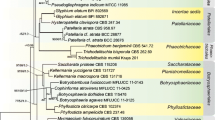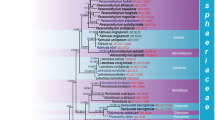Abstract
The coprophilous myxomycete Kelleromyxa fimicola (Dearn. & Bisby) Eliasson was first described in 1929 as Licea fimicola Dearn. & Bisby. Based on the superficial resemblance of its sporocarps to those of Licea biforis, the species was placed within the Liceales, an order assigned by molecular phylogenies to the bright-spored clade of myxomycetes. However, detailed studies of the morphology and life cycle of K. fimicola revealed several characters of the dark-spored order Physarales. To elucidate the systematic position of Kelleromyxa, we obtained three partial and one complete sequence of the SSU rDNA, which demonstrated a clear relationship of K. fimicola to the order Physarales. However, the obtained sequences are not closely related to any of the two known families of Physarales, supporting the erection of a monotypic family for this species. Along with morphological observations, our data support the exclusion of K. fimicola from the order Liceales and placement among the order Physarales within the dark-spored clade of myxomycetes.



Similar content being viewed by others
References
Anonymous (2012) NBS/ISCC Color System. Original and improved 267 color centroids. Washington: Inter-Society Color Council. National Bureau of Standards. On line at http://tx4.us/nbs-iscc.htm (consulted 30 June 2012)
Bisby GR, Buller AH, Dearness J (1929) The Fungi of Manitoba. Longmans, Green, London
Eliasson UH (1977) Recent advances in the taxonomy of Myxomycetes. Bot Not 130:483–492
Eliasson UH (2012) Coprophilous myxomycetes: Recent advances and future research directions. Fungal Divers, online first (doi:10.1007/sl13225-012-0185-6)
Eliasson UH, Keller HW (1999) Coprophilous myxomycetes: updated summary, key to species, and taxonomic observations on Trichia brunnea, Arcyria elaterensis, and Arcyria stipata. Karstenia 39:1–10
Eliasson UH, Lundqvist N (1979) Fimicolous myxomycetes. Bot Not 132:551–568
Eliasson UH, Keller HW, Schoknecht JD (1991) Kelleromyxa, a new generic name for Licea fimicola (Myxomycetes). Mycol Res 95:1201–1207
Estrada-Torres A, Gaither TW, Miller DL, Lado C, Keller HW (2005) The myxomycete genus Schenella: morphological and DNA sequence evidence for synonymy with the gasteromycete genus Pyrenogaster. Mycologia 97:139–149
Fiore-Donno AM, Berney C, Pawlowski J, Baldauf SL (2005) Higher-order phylogeny of plasmodial slime molds (Myxogastria) based on Elongation Factor 1-A and Small Subunit rRNA gene sequences. J Eukaryot Microbiol 52:1–10
Fiore-Donno AM, Meyer M, Baldauf SL, Pawlowski J (2008) Evolution of dark-spored Myxomycetes (slime-molds): molecules versus morphology. Mol Phylogenet Evol 46:878–889
Fiore-Donno AM, Nikolaev SI, Nelson M, Pawlowski J, Cavalier-Smith T, Baldauf SL (2010) Deep phylogeny and evolution of slime moulds (Mycetozoa). Protist 161:55–70
Fiore-Donno AM, Kamono A, Meyer M, Schnittler M, Fukui M, Cavalier-Smith T (2012) 18S rDNA phylogeny of Lamproderma and allied genera (Stemonitales, Myxomycetes, Amoebozoa). PLoS One 7(4):e35359. doi:10.1371/journal.pone.0035359
Guindon S, Gascuel O (2003) A simple, fast, and accurate algorithm to estimate large phylogenies by maximum likelihood. Syst Biol 52:696–704
Hall AT (1999) BioEdit: a user-friendly biological sequence alignment editor analysis program for Windows 95/98/NT. Nucleic Acids Symp Ser 41:95–98
Haugen P, Coucheron DH, Ronning SB, Haugli K, Johansen S (2003) The molecular evolution and structural organization of self-splicing group I introns at position 516 in nuclear SSU rDNA of Myxomycetes. J Eukaryot Microbiol 50:283–292
Huelsenbeck JP, Ronquist F (2001) MrBayes: Bayesian inference of phylogeny. Bioinformatics 17:754–755
Keller HW, Anderson LL (1978) Some coprophilous species of Myxomycetes. ASB Bull 25:67
Keller HW, Everhart SE (2008) Myxomycete species concepts, monotypic genera, the fossil record, and additional examples of good taxonomic practice. Rev Mex Micol 27:9–19
Kirk PM, Ansell AE (1992) Authors of fungal names. A list of authors of scientific names of fungi, with recommended standard forms of their names, including abbreviations. Index of Fungi supplement. CAB International/Latimer Trend, Plymouth
Lanave C, Preparata G, Saccone C, Serio G (1984) A new method for calculating evolutionary substitution rates. J Mol Evol 20:86–93
Lundblad EW, Einvik C, Ronning S, Haugli K, Johansen S (2004) Twelve group I introns in the same pre-rRNA transcript of the myxomycete Fuligo septica: RNA processing and evolution. Mol Biol Evol 21:1283–1293
Mock DL, Kowalski DT (1976) Laboratory cultivation of Licea alexopouli. Mycologia 68:370–376
Nandipati SCR, Haugli K, Coucheron DH, Haskins EF, Johansen SD (2012) Polyphyletic origin of the genus Physarum (Physarales, Myxomycetes) revealed by nuclear rDNA mini chromosome analysis and group I intron synapomorphy. BMC Evol Biol 12:166. doi:10.1186/1471-2148-12-166
Neubert H, Nowotny W, Baumann K, Marx H (1993) Die Myxomyceten Deutschlands und des angrenzenden Alpenraumes unter besonderer Berücksichtigung Österreichs. K. Baumann, Gomaringen
Novozhilov YK, Schnittler M, Erastova DA, Okun MV, Schepin ON, Heinrich E (2012) Diversity of nivicolous myxomycetes of the Teberda State Biosphere Reserve (Northwestern Caucasus, Russia). Fungal Divers, online first (doi:10.1007/s13225-012-0199-0)
Poulain M, Meyer M, Bozonnet J (2011) Les Myxomycètes. Tome 1, guide de determination. Editions FMBDS, Sevrier, France
Rodriguez F, Oliver JL, Marin A, Medina JR (1990) The general stochastic model of nucleotide substitution. J Theor Biol 142:485–501
Schnittler M, Novozhilov YK, Romeralo M, Brown M, Spiegel FW (2012) Fruit body-forming protists: Myxomycetes and myxomycete-like organisms. In: Frey W (ed) Englers Syllabus of Plant Families, vol 1/1, 13th edn. Borntraeger, Stuttgart, pp 40–88
Schoknecht JD, Keller HW (1989) Peridial calcification in the Myxomycetes. In: Crick RE (ed) Origin, Evolution, and modern aspects of biomineralization in plants and animals. Plenum, New York, pp 455–488
Smirnov AV, Chao E, Nassonova ES, Cavalier-Smith T (2011) A revised classification of naked lobose Amoebae (Amoebozoa: Lobosa). Protist 4:545–570
Stamatakis A, Ott M, Ludwig T (2005) RAxML-OMP: An Efficient Program for Phylogenetic Inference on SMPs. In: Proceedings of 8th International Conference on Parallel Computing Technologies (PaCT2005), Lecture Notes in Computer Science, 3506. Springer, Berlin, pp 288–302
Wikmark O-G, Haugen P, Lundblad EW, Haugli K, Johansen S (2007) The molecular evolution and structural organization of Group I introns at 1389 in nuclear small subunit rDNA of Myxomycetes. J Eukaryot Microbiol 54:49–56
Zharkikh A (1994) Estimation of evolutionary distances between nucleotide sequences. J Mol Evol 39:315–329
Acknowledgments
We wish to thank Anja Klahr for assistance with the molecular work at Greifswald. In addition, M.O. owes thanks to several colleagues of the Center for Integrative Bioinformatics in Vienna who helped to find the appropriate approach for phylogenetic analyses. We are grateful to Fionn Clissmann for comments, discussion during manuscript preparation, and language correction. Molecular work was supported by grants from the Russian Foundation for Basic Research (RFBR 10–04–00536a, 12-04-33018 mol_a_ved).
Author information
Authors and Affiliations
Corresponding author
Electronic supplementary material
Below is the link to the electronic supplementary material.
Supplementary Material 1
(FAS 147 KB)
Supplementary Material 2
(FAS 79.0 KB)
Rights and permissions
About this article
Cite this article
Erastova, D.A., Okun, M.V., Fiore-Donno, A.M. et al. Phylogenetic position of the enigmatic myxomycete genus Kelleromyxa revealed by SSU rDNA sequences. Mycol Progress 12, 599–608 (2013). https://doi.org/10.1007/s11557-013-0892-8
Received:
Accepted:
Published:
Issue Date:
DOI: https://doi.org/10.1007/s11557-013-0892-8




